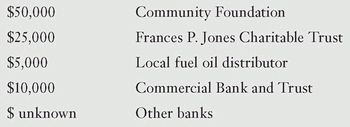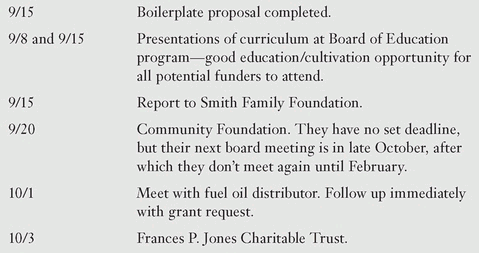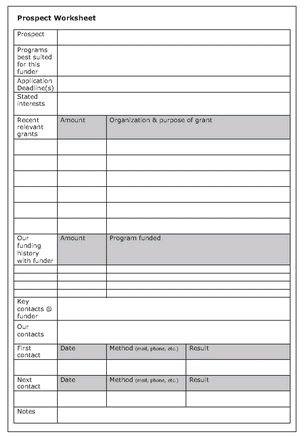Developing a Three-Year Funding Plan
Funders commonly ask you to address how you’ll pay for the program after their funding ends. If you don’t know what will happen programmatically in the second and third years, you can’t know how much it will cost, and therefore cannot know how it will be funded. Asking for a three-year budget might throw program staff for a loop, but if they’ve given you a clear direction, you might be able to construct a rough budget with help from the finance staff. Just be sure the program staff have a chance to review what you end up with if you intend to use it in a proposal. (I discuss budgets in detail in Chapter 15, including multiyear budgets.)
A discussion of future funding plans presents a good opportunity to get information from program staff for any outstanding reports. If activities included in the original grant proposals weren’t completed, be certain to find out why and what, if anything, was done instead. You don’t want to reiterate something in a new proposal that didn’t work the first time.
Following is an outline to use as you develop your funding plan, creating a separate page for each program. The plan will contain broad strokes as to the program and budget, but funding sources and deadlines will be detailed. (A plan created by the program staff would contain information in reverse proportions.) The funding plan isn’t intended to be the outline for your proposal, just the facts on which you’ll later base the proposal. If the program is expected to grow in subsequent years, note that here for future reference.
The most important costs to note in a funding plan are the total project costs. Creating a budget is part of the proposal process. You don’t have to come up with one at this point. If, however, one or two activities or items make up the majority of the expenses for this program, include those details in your plan because they’ll influence which funders you can approach. For example, if the main program expense will be making regrants, your funder list should consist of those that allow regranting.

DEFINITION
Regrants are grants made by a charity with funds it has raised for that purpose. When seeking a grant to support regrants, be sure the funder allows this—many don’t, including many federally funded grants.
Finally, include important deadlines for all activities associated with the program, beginning with grant deadlines, but also including dates for reports, cultivation activities, and any related public programming. When you’ve completed a funding plan for each program, the deadlines from the funding plan sheets will feed into your grant schedule.
Sample Funding Plan for Evergreen Conservation Society


Program #1
Forest land acquisition
Program staff contact: Henry
Purpose
To preserve native forests through acquisition of extensive first- and second-growth tracts, focusing on land adjacent to the nearby national forest. Benefits to the community include preserved watershed and recreation. Additional benefits include wildlife habitat preservation. Goal is to acquire at least 1,000 acres each year for ten years.
Relationship to past programs
In the early 1990s, Evergreen purchased 2,500 acres south of the city, establishing it as a nature reserve for teaching and passive recreation. That land remains largely in its natural state through Evergreen’s management. Funders from that project will be approached for the new one.
Cost
$100,000 to $500,000 each year, depending on the land that is acquired, in direct costs plus $15,000 to $22,000 in personnel and indirect costs each year.
Funders for the first year 



Funders for subsequent years
Renewals from Bunyan and Wildfowl
Need to find five additional prospects by end of September. Look for capital funders as well as other environmental funders.
Important deadlines and other dates 

Program #2
Environmental education on the secondary level county wide
Program staff contact: Mary
Purpose
To provide instructors to work with teachers in public and private secondary schools to integrate environmental awareness and knowledge into secondary school curricula. A model curriculum will be made available and the instructors will assist teachers in adapting it for use in various courses. Instructors will also be available to give special lectures during or after school hours.
Relationship to past programs
Evergreen has offered evening classes in environmental studies to an adult lay audience for more than 15 years. Nature talks have been offered at Evergreen’s nature preserve to groups of mixed ages since 1998. Last year, a grant from the Smith Family Foundation made possible the creation of a curriculum for secondary schools, which will serve as the basis for this program.
Cost
$65,000 for instructor fees, coordination by Evergreen’s education department, and printing of curriculum materials.
Funders for the first year

Funders for subsequent years
Smith Family Foundation: $25,000. Although they paid for the curriculum development, they made it clear they wanted to see other funders make a commitment to the program and would not make another grant this year.
State Department of Education: $50,000 over two years. We just missed this year’s deadline due to a delay in completing the curriculum. (They have an 18-month time lag from application to start of grant period.)
Renewals from some first-year funders.
Important deadlines and other dates

You might not have all the prospects you need for a program (especially for the second and third years) when developing your plan. That’s fine, but note the number of funding sources you need to approach and a date when you expect to complete the research to find them. The amounts you request from your prospects should add up to much more than the program cost—not all your proposals will be successful, no matter how good a job you do.
Also note which funders have supported each program or another program at your charity in the past. Remember to include funders for every sector: foundation, corporate, government, and individual major gifts.
For each funder on your schedule, you’ll want to compile a prospect worksheet, which summarizes your plan to approach the funder, relevant grants it has made to other organizations, your current and past relationship with the funder, and contact information.
You can download the Funding Plan Worksheet, Grant Schedule Worksheet, and Prospect Worksheet templates at idiotsguides.com under “Book Extras.”

A prospect worksheet helps you keep track of the details on each funder.
..................Content has been hidden....................
You can't read the all page of ebook, please click here login for view all page.
